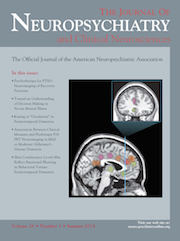Electroconvulsive Therapy and Posttraumatic Stress Disorder: First Experience With Conversation-Based Reactivation of Traumatic Memory Contents and Subsequent ECT-Mediated Impairment of Reconsolidation
To the Editor: Strong and recurrent activation of traumatic memory contents (TMC) was suggested to be an essential pathophysiologic mechanism in posttraumatic stress disorder (PTSD).1 Thus, reduced activation or availability of this particular TMC could result in amelioration of PTSD core symptoms. Against the background that affected neurocognitive functioning, especially transient impairment of memory functioning, is a common side effect of ECT,2 one might argue that the recently demonstrated efficacy of ECT in the treatment of PTSD3 might be due to impaired reactivation of TMC. Consolidated memory contents are suggested to be destabilized during their retrieval, and thus, sensitive for modifications at the time of their current recall and reconsolidation.4 Hence, ECT might be most effective immediately after an active (conversation-based) confrontation with the TMC. Here, we report amelioration of therapy-refractory PTSD due to successful ECT-mediated extinction of one TMC.
Case Report
“Mr. A,” a 49-year-old man, suffered from therapy-refractory PTSD for approximately 7 years following a serious traffic accident and several episodes of sexual abuse in his childhood. In the past, he had been treated for PTSD with trauma focused cognitive-behavioral therapy and multiple antidepressant agents in sufficient dosages and treatment durations without significant amelioration of PTSD. In addition, at the time of admission the patient presented a severe major depressive episode. Taking into account the failed common treatment regimens until now and the theoretical efficacy of ECT regarding core symptoms of PTSD, an intradepartmental discourse including the head of the department and several senior physicians was conducted in order to trade off possible beneficial ECT-effects against ethical and medical concerns. The patient participated in this discussion and was comprehensively informed of the intended procedure. After the patient gave his written informed consent regarding the intended procedure, we performed eight sessions of right unilateral ECT (three sessions per week). Considering that the patient´s PTSD was due to multiple traumas, we selected one traumatic event (traffic accident) to be modified. In order to destabilize the TMC regarding the traffic accident, a conversation-based reactivation of this particular TMC was performed immediately before ECT (duration of 10 minutes). The patient was advised to remember the accident and to describe his particular memories verbally (average time between end of memory reactivation and application of etomidate: 10 minutes). We did not observe any significant side effects related to ECT. Daily medication throughout the procedure was sertraline 200 mg and trimipramine 75 mg. During and after the ECT course, the patient reported improvement of PTSD-symptoms accompanied by a more clear improvement of depression (Table 1). PTSD-symptoms related to the accident subsided completely and though PTSD-symptoms persisted, they were not accompanied by memories related to the accident. Moreover, the patient reported that he could hardly remember the reprocessed TMC.
| Before ECT | After Eight Sessions RUL ECT | Twelve Weeks After Last ECT Session | |
|---|---|---|---|
| HAMD | 21 | 9 | 10 |
| BDI-II | 27 | 18 | 19 |
| MADRS | 22 | 10 | 11 |
| CAPS–2 | 80 | 52 | 53 |
| IES-R | 1.83 | 1.32 | 1.38 |
The presented case provides preliminary evidence for the possible efficacy of ECT in the treatment of therapy-refractory PTSD by specific elimination of one particular TMC. However, PTSD symptoms did not subside completely. This is partly explained by the fact that the patient´s PTSD was due to multiple traumas.
1 : The relationship between cognitive control and posttraumatic stress symptoms. J Behav Ther Exp Psychiatry 2012; 43:844–848Crossref, Medline, Google Scholar
2 : Neurocognitive effects after brief pulse and ultrabrief pulse unilateral electroconvulsive therapy for major depression: a review. J Affect Disord 2012; 140:233–243Crossref, Medline, Google Scholar
3 : Efficacy of ECT in chronic, severe, antidepressant- and CBT-refractory PTSD: an open, prospective study. Brain Stimulat 2010; 3:28–35Crossref, Medline, Google Scholar
4 : Neural signature of reconsolidation impairments by propranolol in humans. Biol Psychiatry 2012; 71:380–386Crossref, Medline, Google Scholar



